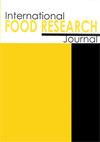Effects of reactive extrusion on cross-linking of corn starch
IF 1
4区 农林科学
Q4 FOOD SCIENCE & TECHNOLOGY
引用次数: 0
Abstract
The present work aimed to evaluate the efficiency of the dual modification of corn starch by reactive extrusion, using a mono-thread extruder, and also sodium tripolyphosphate and trimetaphosphate to obtain cross-linked starch. Native starch, extruded native starch, and starch cross-linked by conventional methods were used as standards to evaluate the modification efficacy by reactive extrusion. The content of phosphorus residues allowed by legislation in starch modification is 0.4%. Therefore, the reactive extrusion demonstrated greater effectiveness because cross-linked starch obtained by this method was within the established limit of phosphorus residues, in contrast to that obtained by the conventional method, which exceeded this amount. In addition, it required greater water consumption for residual removal, therefore producing effluents, and also wasting energy and time. Cross-linking by the extrusion process showed a profound influence on the characteristics of modified starch, generating specific functional characteristics, mainly in terms of pasting properties. Also, the samples presented low viscosity and pasting temperature. In conclusion, cross-linking through reactive extrusion was fast, produced starch with phosphorus content within the limits allowed by legislation, and generated different physicochemical characteristics.反应挤压对玉米淀粉交联的影响
研究了用单丝挤出机和三聚磷酸钠、三偏磷酸钠对玉米淀粉进行双重改性,得到交联淀粉的效果。以天然淀粉、挤出的天然淀粉和常规交联的淀粉为标准,评价反应挤出改性的效果。法定淀粉改性中磷残留量为0.4%。因此,反应挤压显示出更大的有效性,因为用这种方法得到的交联淀粉在磷残留量的规定范围内,而传统方法得到的磷残留量超过了这个限度。此外,它需要消耗更多的水来去除残留物,因此产生废水,也浪费了能源和时间。挤压交联对变性淀粉的特性产生了深远的影响,产生了特定的功能特性,主要表现在糊化性能方面。样品具有较低的黏度和黏度。综上所述,反应挤出交联速度快,制备的淀粉含磷量在法律允许的范围内,并产生不同的理化特性。
本文章由计算机程序翻译,如有差异,请以英文原文为准。
求助全文
约1分钟内获得全文
求助全文
来源期刊

international food research journal
Agricultural and Biological Sciences-Food Science
CiteScore
1.40
自引率
0.00%
发文量
75
期刊介绍:
The International Food Research Journal (IFRJ) publishes papers in English, six (6) issues a year with the coverage of:
Food Science and Technology
Nutrition and Dietetics
Agriculture, multidisciplinary
Chemistry, multidisciplinary
The scope of the Journal includes:
Food Science, Food Technology and Food Biotechnology
Product Development and Sensory Evaluation
Food Habits, Nutrition, and Health
Food Safety and Quality
Food Chemistry, Food Microbiology, Food Analysis and Testing
Food Engineering
Food Packaging
Food Waste Management
Food Entrepreneur
Food Regulatory
Post-Harvest Food Management
Food Supply Chain Management
Halal Food and Management
 求助内容:
求助内容: 应助结果提醒方式:
应助结果提醒方式:


